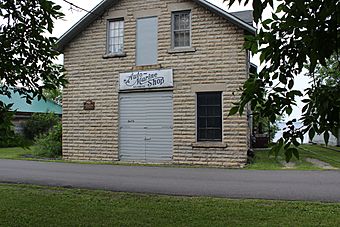Finstad's Auto Marine Shop facts for kids
Quick facts for kids |
|
|
Finstad's Auto Marine Shop
|
|

Finstad's Auto Marine Shop from the south
|
|
| Location | 3475 Finstad Lane, Ranier, Minnesota |
|---|---|
| Area | Less than one acre |
| Built | 1911 |
| Architect | Jim DiOnne |
| NRHP reference No. | 83000906 |
| Added to NRHP | January 27, 1983 |
Finstad's Auto Marine Shop was a special place in Ranier, Minnesota. It was a shop where boats and cars were fixed. Built in 1911, it sat right on the shore of Rainy Lake. Inside, it still had its old-fashioned machines that ran with belts!
George Finstad bought the shop in 1924. For over 50 years, he helped fishermen, locals, and visitors. He fixed their boats and stored them safely. This building is now on the National Register of Historic Places. It's important because it shows how people enjoyed the outdoors and traveled in the early 1900s. It also played a big part in the growth of Koochiching County.
Contents
What the Shop Looked Like
Finstad's Auto Marine Shop was built from concrete blocks. It had a roof shaped like a triangle. Big double doors were at the front, letting cars drive right inside for repairs. At the back, another set of double doors opened to the lake. This made it easy to bring boats in and out.
Inside, the shop had a cool system. A central machine used belts to power other tools. These tools included a drill and a lathe (a machine for shaping wood or metal). The second floor of the shop had living quarters.
A Look Back: Shop History
The shop was built in 1911 by Jim DiOnne. He was a gunmaker and also sold cars. In 1922, DiOnne hired George Finstad. George was a veteran from World War I and grew up in Buyck, Minnesota. For two years, George learned a lot about machines and repairs from DiOnne.
George Finstad Takes Over
Later, George bought the business with his brother. He then bought out his brother's share. George Finstad decided to focus only on boats. He stopped working on guns and cars. He fixed boats for fun and for people who fished for a living. He also sold and repaired boat motors and parts. George's wife, Clara, managed all the shop's paperwork.
Boating Fun on Rainy Lake
After World War I, more people started enjoying outdoor activities. Travel became easier with better roads and affordable cars. People came to Ranier by car or by train on the Duluth, Winnipeg and Pacific Railway. They would launch their boats and canoes from the town dock. Then they would head to campsites on the many islands in Rainy Lake.
Rainy Lake had lots of rocks and fallen logs. This meant boats and motors often got damaged. Finstad's shop was right by the lake, offering quick and helpful service.
Wealthy Visitors and Fancy Boats
In the 1920s and 1930s, Rainy Lake became a popular summer spot. Rich families from big cities came to escape the heat and smog. They built large homes on the lake's islands. Famous families like the Pillsburys (who made flour) visited. So did William Hapgood, who owned a cannery, and Major Horace Roberts, who made prefabricated homes.
George Finstad took care of their fancy wooden speedboats. These included Chris-Crafts, Hacker-Crafts, and Gar Woods. Even bigger yachts sailed on Rainy Lake. The James Ford Bell family had a 44-foot cruiser called the Loafden. Major Roberts owned a 50-foot yacht named the Virginia.
Launching Big Yachts
When a new yacht arrived, it was a big event in Ranier. Crowds would gather at Finstad's shop to watch it launch. The boats came by truck or train. They were packed in special cradles to keep them safe. Finstad used his "marine railroad" to move the yachts. This was a track that slid the boats down a two-block slope into Rainy Lake.
Every fall, Finstad used the same railway to pull the yachts out of the water. He would cover them with canvas tarps. Then he stored them on their special cradles. Over the winter, he repaired and prepared the boats. They would be ready for launching again in the spring.
Changes After the War
Rainy Lake was very busy in the 1920s and 1930s. But during World War II, things became quiet. George Finstad spent the war years working at a paper mill in nearby International Falls.
After the war, the wealthy families slowly stopped coming to their summer homes. Their old cabins seemed too simple compared to new, modern homes. Many of the elegant yachts were sold. Some were moved to lakes closer to the Twin Cities.
New boats made of aluminum and fiberglass became popular. These boats were cheaper and easier to store at home. So, Finstad's winter storage business slowed down. But his business selling and fixing Johnson Outboard Motors kept him busy. He continued to sell and repair motors and fix boats until he passed away in 1975. Clara Finstad kept the shop running until 1992.



